GRE MATH REVIEW
Geometry
As in the case of algebra, you don’t need to know much of the actual geometry you learned in your geometry class for the GRE. Here is a list of facts about degrees and angles that you should know for the GRE:
1.A circle contains 360 degrees (360°).
2.A line is a 180° angle, i.e. a perfectly flat angle.
3.When two lines intersect, four angles are formed, and the sum of these angles
is 3600.
4.When two lines are perpendicular to each other, their intersection forms four
90° angles. The symbol used on the GRE to indicate
perpendicularity is ⊥.
5.Ninety-degree angles are also called right angles. A right angle on the GRE is
identified by the following symbol:

6.When two parallel lines, indicated by the symbol // , are cut by a third line, angles that look equal are equal. This is easier to remember than the definitions of corresponding exterior and interior angles that you learned in geometry class. However, be careful when applying this rule since diagrams in the GRE are often not drawn to scale . The following diagram is an example to which this rule applies.
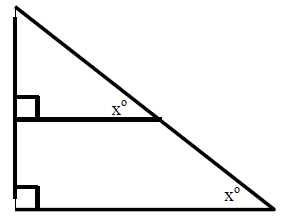
7. When two lines intersect, the angles across from each other, which are called vertical angles, are equal. See the diagram below.
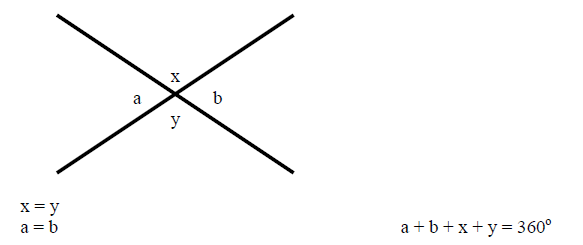
There are also many facts about triangles that you need to know for the GRE.
For instance, every triangle contains three interior angles which add up to 180°
no matter what the shape of the triangle. For example: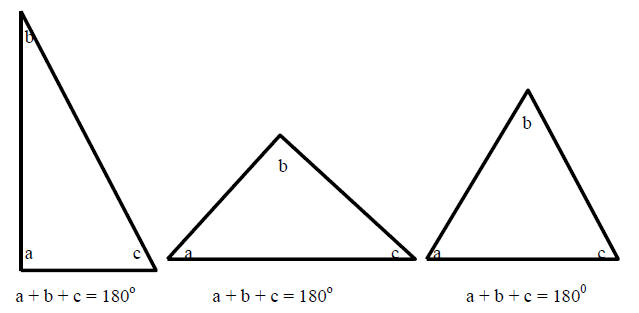
An equilateral triangle is one in which all three sides are equal in length. Since the sides are equal, all the angles are equal too. Hence, each angle in an equilateral triangle is 60°. The following is a diagram of an equilateral triangle:
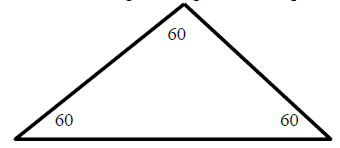
An isosceles triangle is one in which two of the three sides are equal in length. Hence, the two angles opposite these sides are also equal in length. If you know the degrees of any angle in an isosceles triangle, you can easily figure out the degrees of the other two. For example, if one of the two equal angles equals 40°, then the other angle is also 40 degrees. Hence, the third angle is 180° – 80° = 100° degrees. This same strategy also applies to the length of the sides. The following is a diagram of an isosceles triangle. Remember though: you can’t just assume two sides or angles are equal because they look equal except in the case described in #6 above. Be careful; the diagrams on the GRE are NOT always drawn to scale.
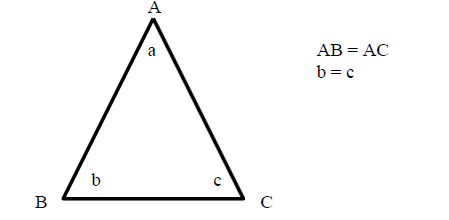
A right triangle is a triangle in which one of the angles is a right angle, i.e. a 90° angle. The symbol mentioned earlier will be used to indicate the right angle in a right triangle. The longest side of a right triangle, which is the side opposite the 90-degree angle, is called the hypotenuse.
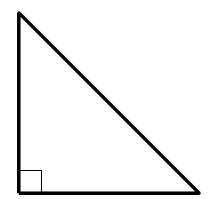
In any triangle, the longest side is opposite the largest angle, and the shortest side is opposite the smallest angle. If two interior angles are equal, the sides opposite them are also equal as in the case of an isosceles triangle and an equilateral triangle.
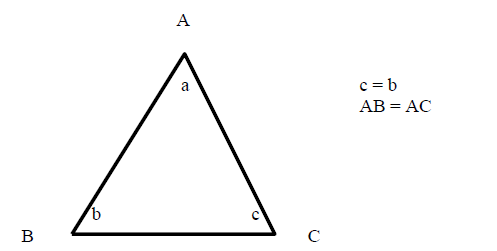
The perimeter of a triangle is the sum of the lengths of the sides of the triangle.
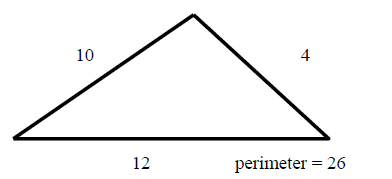
The area of a triangle is the product of the base and the height of the triangle multiplied by 1/2:
area = (1/2)•base •height
This formula is for the area of any triangle even though the height of some triangles may not be immediately obvious. For example:
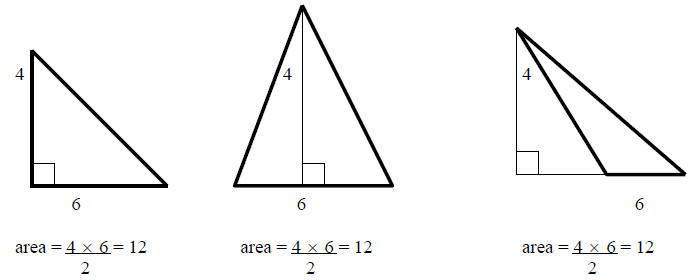
The Pythagorean theorem is probably the most difficult geometry concept on the GRE, but you must know it. The Pythagorean theorem applies only to right triangles. In a right triangle, the square of the hypotenuse is equal to the sum of the squares of the other two sides. In the triangle below, c^2 = a^2 + b^2.
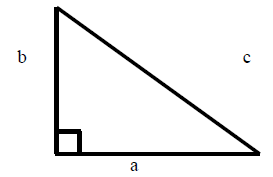
Pythagorean problems on the GRE often involve right triangles with side lengths 3, 4, and 5 or multiples of these numbers . This particular triangle is the smallest one in which the side lengths are all integers. Here are three examples of 3-4-5 right triangles that you could see on the GRE. Learn to recognize multiples of the lengths 3, 4, and 5.

The Pythagorean theorem can also be used to solve other problems in which the application isn’t as obvious. For example, every square or rectangle is made up of two right triangles. Hence, if you know the length and width of any rectangle or square, you can find the length of the diagonal by using the Pythagorean theorem. For example, if the lengths of the sides of the rectangle below are 3 and 4, then using the Pythagorean theorem, 3^2 + 4^2 = 9 + 16 = 25. Hence, the length of the diagonal is 5.
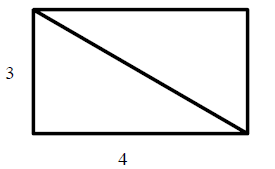
There are two special right triangles that you will see on the GRE. You need to commit these triangles and their characteristics to memory.
1. The first of these triangles is called the 30:60:90 right triangle, referring to the degree measurements of the angles:
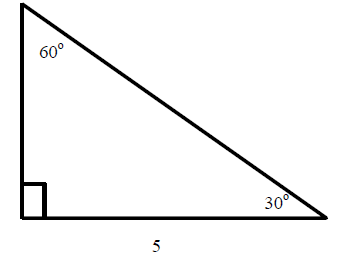
The ratio between the lengths of the sides in a 30:60:90 degree triangle is
constant. So, if you know the length of any side, you can find the lengths of
the other two sides. The constant ratio is
 .
In other words, if the shortest side has length 5, then the hypotenuse has
length 10 and the other side has length
.
In other words, if the shortest side has length 5, then the hypotenuse has
length 10 and the other side has length
 .
Here are two examples of 30:60:90 triangles:
.
Here are two examples of 30:60:90 triangles:

2. The second special right triangle is the 45:45:90 right triangle in
which the two sides opposite the hypotenuse are equal. The ratio between the
length of either of these sides and the length of the hypotenuse is
 .
In other words , if the length of each short leg is 5 , then the length of the
hypotenuse is
.
In other words , if the length of each short leg is 5 , then the length of the
hypotenuse is
 .
Here are two examples:
.
Here are two examples:

In algebra class , you learned that the value of pi (π) is 3.14 or 3.14159. However, on the GRE you can approximate π as 3. Three is a close enough approximation to find the correct answer on the GRE and it is much easier to work with than 3.14. Some problems on the GRE involving π can be solved simply by plugging in 3 for each π in the answer choices and comparing the results.
The circumference of a circle is like the perimeter of a triangle: it is the distance around the outside. The circumference of a circle is the product of pi and the radius r multiplied by 2 or pi times the diameter d:
circumference = 2πr = πd
You also need to remember the relationship that π expressed. Pi is the
ratio between the circumference of a circle and its diameter. Since π is
approximately 3, then every circle is approximately three times as far around as
it is across. If the diameter of a circle is 4, then its radius is 2 and its
circumference is 4π, or approximately 12. If the circumference is 10, then its
diameter is 10/π, or a little more than 3, and its radius is 5/π, or a little
more than 1.5.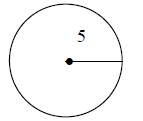
circumference = 2 π r = 2 π 5 = 2 × 3 × 5 = 30
The area of a circle is the product of pi and the square of the radius:
area = π r^2
For example, if the radius of a circle is 5, then the area is approximately 3 times 25 or approximately 75:
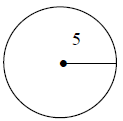
area = π r^2 = π × 25 = 3 ×25 = 75
The perimeter of a rectangle is just like the perimeter of a triangle: the sum of the lengths of the sides. For example:
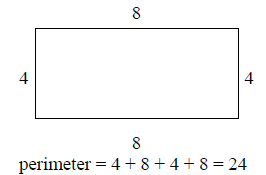
The area of rectangle is the length of the rectangle times its width: area = length • width. In the example just above, the area is (8)(4) = 32.
A square is just a rectangle with 4 equal sides, s. Therefore, the perimeter is just 4 times the length of a side, i.e. perimeter = 4s. The area of a square is just the length of a side s times itself or the square of the length of a side, i.e. area = s^2.
The only geometric figure for which you will have to calculate the volume is a rectangular solid, or a box. The volume of a box is just the length times the width times the height:
volume = length •width •height
You will also need to be familiar with the Cartesian coordinate system shown below. The horizontal axis is the x-axis; the vertical axis is the y-axis. The four areas formed by these axes are called quadrants. The point where the two axes intersect is called the origin.
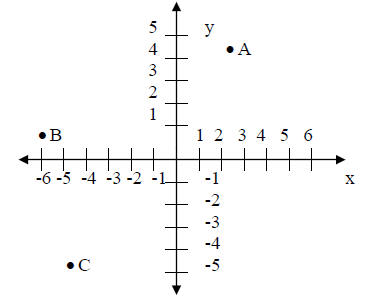
The Cartesian coordinate system is a method of describing the location of any point on the plane formed by the two axes. In the diagram above, the point A can be described by the coordinates (2, 4) where 2 is the distance to the right of the origin on the x-axis and 4 is the distance above the origin on the y-axis. The coordinates (-6, 1) describe the point B which is 6 spaces to the left of the origin on the x-axis and 1 space above the origin on the y-axis.
EXERCISE 6
1. In the figure below, if l1// l2 , what is the measure of angle b?
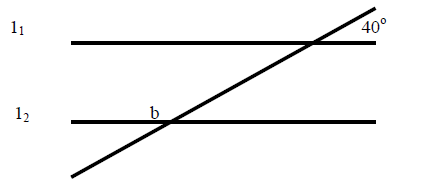
2. In the triangle below, what is the measure of angle c?

3. In the triangle below, what is the length of side AB?
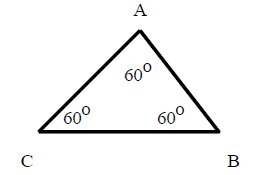
4. In the triangle below, what is the measure of angle c?
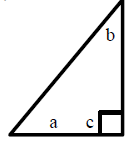
5. What are the perimeters of the triangle and rectangle below?

6.What are the areas of the triangle and rectangle below?

7.What is the length of the third side in the right triangle below?
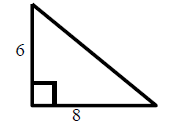
8.What is the approximate circumference of the circle below?
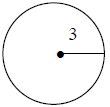
9.What is the approximate area of the circle in problem 8?
10.If a box is 5 inches wide, 10 inches long, and 4 inches deep, what is its volume in cubic inches ?
11.Determine the coordinates of points A, B, C, and D in the graph below .
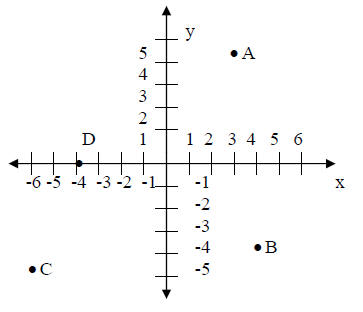
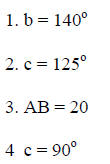
5. triangle perimeter = 11
rectangle perimeter = 14
6. triangle area = 16
rectangle area = 24
7. 10
8. approximately 18
9. approximately 27
10. volume = 200 cubic inches
11. A = (3, 4)
B = (4, -4)
C = (-6, -5)
D = (-4, 0)
| Prev | Next |